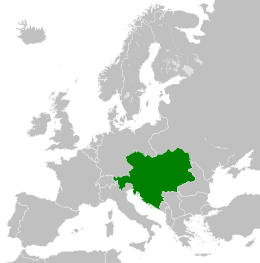More languages
More actions
| Austro-Hungarian Monarchy Österreichisch-Ungarische Monarchie (German) Osztrák–Magyar Monarchia (Hungarian) | |||||||||||||||||||||||||
|---|---|---|---|---|---|---|---|---|---|---|---|---|---|---|---|---|---|---|---|---|---|---|---|---|---|
| 1867–1918 | |||||||||||||||||||||||||
Motto: Indivisibiliter ac inseparabiliter Indivisibly and inseparably | |||||||||||||||||||||||||
Anthem: Gott erhalte Franz den Kaiser | |||||||||||||||||||||||||
 Austro-Hungary in 1914 | |||||||||||||||||||||||||
| Capital | Vienna (Austria) Budapest (Hungary) | ||||||||||||||||||||||||
| Largest city | Vienna | ||||||||||||||||||||||||
| Official languages | German Hungarian Serbo-Croatian | ||||||||||||||||||||||||
| Dominant mode of production | Capitalism | ||||||||||||||||||||||||
| Government | Monarchy | ||||||||||||||||||||||||
| Area | |||||||||||||||||||||||||
• Total | 621,538 km² | ||||||||||||||||||||||||
| |||||||||||||||||||||||||
Austria-Hungary, officially the Austro-Hungarian Monarchy, often referred to as the Austro-Hungarian Empire or the Dual Monarchy, was a multi-ethnic state in Central Europe, established in 1867 as a compromise between the declining Habsburg monarchy that was trying to preserve its power and Hungarians who sought greater autonomy. The ruler of the empire ruled as both Emperor of Austria and King of Hungary.[1]
First World War
Austria-Hungary blamed Serbia for the death of Archduke Franz Ferdinand, as the assassin (Gavrilo Princip) happened to be a Bosnian Serb, and attacked Serbia on 28 July 1914, beginning the First World War.[1]
Demographics
Austria-Hungary contained 12 million Austrians, 10 million Hungarians, 6.6 million Czechs, 5 million Poles, 4 million Ukrainians, 3.2 million Croats, 2.9 million Romanians, 2 million Slovaks, 1.3 million Slovenes, and 700,000 Italians.[1]
References
- ↑ 1.0 1.1 1.2 Neil Faulkner (2013). A Marxist History of the World: From Neanderthals to Neoliberals: 'Imperialism and War' (p. 183). [PDF] Pluto Press. ISBN 9781849648639 [LG]


